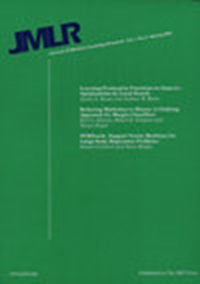Beyond the Quadratic Approximation: The Multiscale Structure of Neural Network Loss Landscapes
IF 5.2
3区 计算机科学
Q1 AUTOMATION & CONTROL SYSTEMS
引用次数: 13
Abstract
A quadratic approximation of neural network loss landscapes has been extensively used to study the optimization process of these networks. Though, it usually holds in a very small neighborhood of the minimum, it cannot explain many phenomena observed during the optimization process. In this work, we study the structure of neural network loss functions and its implication on optimization in a region beyond the reach of a good quadratic approximation. Numerically, we observe that neural network loss functions possesses a multiscale structure, manifested in two ways: (1) in a neighborhood of minima, the loss mixes a continuum of scales and grows subquadratically, and (2) in a larger region, the loss shows several separate scales clearly. Using the subquadratic growth, we are able to explain the Edge of Stability phenomenon [5] observed for the gradient descent (GD) method. Using the separate scales, we explain the working mechanism of learning rate decay by simple examples. Finally, we study the origin of the multiscale structure and propose that the non-convexity of the models and the non-uniformity of training data is one of the causes. By constructing a two-layer neural network problem we show that training data with different magnitudes give rise to different scales of the loss function, producing subquadratic growth and multiple separate scales.超越二次逼近:神经网络损失景观的多尺度结构
神经网络损失景观的二次逼近已被广泛用于研究这些网络的优化过程。虽然它通常存在于极小值的一个很小的邻域内,但它不能解释优化过程中观察到的许多现象。在这项工作中,我们研究了神经网络损失函数的结构及其对超出良好二次逼近范围的区域优化的意义。数值上,我们观察到神经网络损失函数具有多尺度结构,表现在两个方面:(1)在最小邻域内,损失混合了尺度连续体并以次二次增长;(2)在更大的区域内,损失清晰地显示出几个独立的尺度。利用次二次增长,我们能够解释梯度下降(GD)方法所观察到的稳定性边缘现象[5]。我们使用单独的量表,通过简单的例子解释了学习率衰减的工作机制。最后,我们研究了多尺度结构的起源,提出模型的非凸性和训练数据的非均匀性是多尺度结构产生的原因之一。通过构造一个两层神经网络问题,证明了不同量级的训练数据会产生不同尺度的损失函数,产生次二次增长和多个分离尺度。
本文章由计算机程序翻译,如有差异,请以英文原文为准。
求助全文
约1分钟内获得全文
求助全文
来源期刊

Journal of Machine Learning Research
工程技术-计算机:人工智能
CiteScore
18.80
自引率
0.00%
发文量
2
审稿时长
3 months
期刊介绍:
The Journal of Machine Learning Research (JMLR) provides an international forum for the electronic and paper publication of high-quality scholarly articles in all areas of machine learning. All published papers are freely available online.
JMLR has a commitment to rigorous yet rapid reviewing.
JMLR seeks previously unpublished papers on machine learning that contain:
new principled algorithms with sound empirical validation, and with justification of theoretical, psychological, or biological nature;
experimental and/or theoretical studies yielding new insight into the design and behavior of learning in intelligent systems;
accounts of applications of existing techniques that shed light on the strengths and weaknesses of the methods;
formalization of new learning tasks (e.g., in the context of new applications) and of methods for assessing performance on those tasks;
development of new analytical frameworks that advance theoretical studies of practical learning methods;
computational models of data from natural learning systems at the behavioral or neural level; or extremely well-written surveys of existing work.
 求助内容:
求助内容: 应助结果提醒方式:
应助结果提醒方式:


